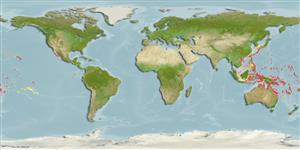>
Blenniiformes (Blennies) >
Blenniidae (Combtooth blennies) > Salariinae
Etymology: Crossosalarias: Greek krossoi = tassel + Latin, salar, salaris = trout (Ref. 45335).
Environment: milieu / climate zone / depth range / distribution range
Ecología
marino asociado a arrecife; rango de profundidad 1 - 25 m (Ref. 9710), usually ? - 10 m (Ref. 9710). Tropical
Western Pacific: east to Tonga.
Tamaño / Peso / Age
Maturity: Lm ? range ? - ? cm
Max length : 10.0 cm TL macho / no sexado; (Ref. 9710)
Espinas dorsales (total): 12; Radios blandos dorsales (total): 16-18; Espinas anales 2; Radios blandos anales: 18 - 20. Dorsal fin spines elongate, extending beyond membrane. Terminal anal ray connected by membrane to caudal peduncle. Gill opening narrow and restricted, slightly below the level of the ventralmost pectoral ray. Some preopercular and mandibular pores with cirri. A black, fleshy flap at the base of the 1st dorsal spine. A black blotch is present ventrally on each side of the head.
Adults are found in seaward reefs (Ref. 9710). Also inhabit shallow, semi-exposed, hard-coral and rock reef with rich algae growth (Ref. 48636). Oviparous. Eggs are demersal and adhesive (Ref. 205), and are attached to the substrate via a filamentous, adhesive pad or pedestal (Ref. 94114). Larvae are planktonic, often found in shallow, coastal waters (Ref. 94114).
Life cycle and mating behavior
Madurez | Reproducción | Puesta | Huevos | Fecundidad | Larva
Oviparous, distinct pairing (Ref. 205).
Randall, J.E., G.R. Allen and R.C. Steene, 1990. Fishes of the Great Barrier Reef and Coral Sea. University of Hawaii Press, Honolulu, Hawaii. 506 p. (Ref. 2334)
IUCN Red List Status (Ref. 130435)
Threat to humans
Harmless
Human uses
Más información
ReferenciasAcuiculturaPerfil de acuiculturaRazasGenéticaElectrophoresesheritabilidadEnfermedadesProcesamientoNutrientsMass conversion
ColaboradoresImágenesStamps, Coins Misc.SonidosCiguateraVelocidadTipo de nataciónSuperficie branquialOtolitosCerebrosVisión
Herramientas
Special reports
Download XML
Fuentes de Internet
Estimates based on models
Preferred temperature (Ref.
123201): 24.6 - 29.3, mean 28.5 °C (based on 1754 cells).
Phylogenetic diversity index (Ref.
82804): PD
50 = 1.0000 [Uniqueness, from 0.5 = low to 2.0 = high].
Bayesian length-weight: a=0.00741 (0.00335 - 0.01640), b=3.02 (2.83 - 3.21), in cm total length, based on LWR estimates for this (Sub)family-body shape (Ref.
93245).
Resiliencia (Ref.
120179): Alto, población duplicada en un tiempo mínimo inferior a 15 meses (Preliminary K or Fecundity.).
Fishing Vulnerability (Ref.
59153): Low vulnerability (10 of 100).
Nutrients (Ref.
124155): Calcium = 146 [73, 228] mg/100g; Iron = 0.797 [0.477, 1.313] mg/100g; Protein = 18.2 [17.1, 19.2] %; Omega3 = 0.0963 [, ] g/100g; Selenium = 25.1 [12.4, 51.6] μg/100g; VitaminA = 128 [40, 403] μg/100g; Zinc = 2.15 [1.47, 3.02] mg/100g (wet weight);
